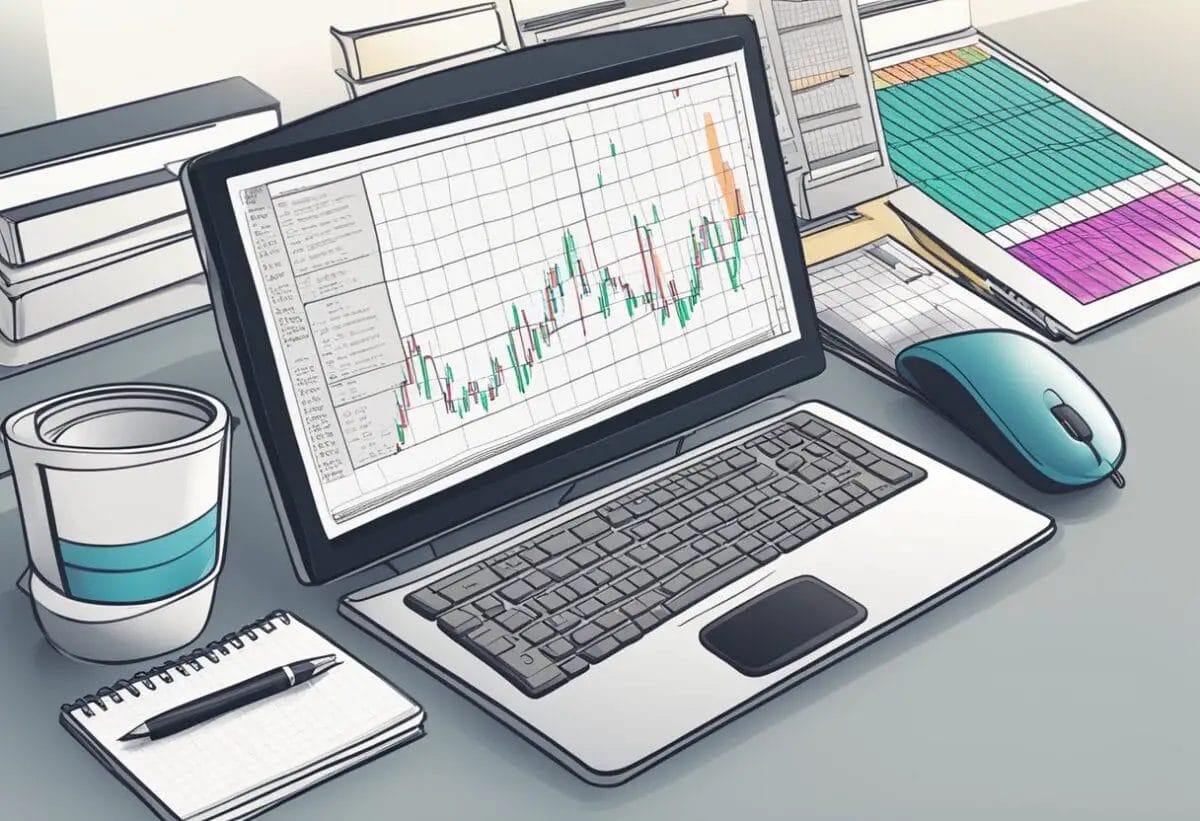Day Trading For Beginners: Guide On How To Become a Day Trader
Disclaimer: The information on this page is for your convenience only. By accessing this website you’ve agree on our T&C. We do not offer tax or investing advisory or brokerage services, nor do we recommend or advise anyone to buy or sell particular stocks, securities or other investments.
Have you ever through of becoming a full time day trader? Sitting on your butt all day and earn thousands of dollars with just a click of your button?
Well, I have. I’ve been longing to become a day trader and get the thrill of getting a few thousands dollar richer in just a day.
But the truth isn’t as rosy as it may seems. Becoming a day trader is easy, but becoming one that actually makes a profit isn’t. Ignore those advertisement about getting rich quick, here is the truth you need to know.
KEY TAKEAWAYS
- Call Options is the “right to buy” an asset and Put Options is the “right to sell” an asset at a predetermined price before the contract expires.
- Put strategy: Buy puts to hedge your position to serve as an insurance or sell cash secured puts to collect premium.
- Call strategy: Buy call to speculate a raising position to capture a larger gains or sell covered calls to collect premium.
- Never sell naked call, your risk is unlimited as the market price can be infinite in the upward direction.
- Never sell naked put, you will risk having to buy the stock even when you do not have the cash required when the price drop to your strike price.
What is Day Trading?
Day trading is the practice where you buy and sell stocks or other securities within a single trading day or over a short period of time. Day traders aim to make profits off small price movements of a particular securities.
A day trader focuses on using technical analysis to try predict future price movement, respond swiftly to market-moving news or economic reports throughout the trading day.
Day trader don’t rely on fundamental value of stocks for each investment decision, but instead, they rely on indicators such as past price data and trading patterns for each of their trades.
As a day trader, your trading account acts as a tool to facilitate these quick transactions.
- Access to real-time market data
- Instant trade execution
- Leverage, or trading with borrowed money to potentially amplify gains, as well as increase losses.
To engage in day trading, you need to understand the trading rules set by the regulatory authorities. For US market, FINRA and the SEC states that Pattern Day Traders must maintain a $25,000 balance in their brokerage account and follow the PDT rules.For
As for Singapore listed stocks, I am not aware of similar trading rules when I check the SGX website. If I’ve miss out anything do drop me a message at the comments below so we can get the community aware.
Day Trading Strategy

Day trading can be profitable, but it comes with high stakes and requires a combination of knowledge, strategy, and discipline. Always start with a clear trading plan and use only risk capital money you can afford to lose.
Here are some common day trading strategy you may see.
- Momentum Trading: Seize market opportunities by identifying trending securities. Momentum traders use stock scanners and technical analysis to enter positions strategically for maximum returns.
- Contrarian Trading: Navigate market shifts confidently. Contrarian traders profit from trend reversals and overreactions, leveraging precise timing for successful trades.
- News Trading: Stay ahead with timely trades. News traders capitalize on volatility, utilizing breaking news and major events to execute profitable transactions.
- Range Trading: Optimize profits within price boundaries. Range traders capitalize on predictable market fluctuations by buying low and selling high within established price ranges.
- Scalping: Unlock quick profits with rapid trades. Scalpers capitalize on short-term price movements, executing frequent transactions for incremental gains in dynamic markets.
- Fading: Profit from market reversals. Fading strategies involve trading against prevailing trends, aiming to capitalize on overextended price movements and potential reversals.
Each strategy utilizes various tools:
- Technical Indicators: Help in predicting future price movements based on historic data.
- Chart Patterns: Offer visual cues to price action and potential market direction.
- News Events: Provide opportunities to trade based on the impact of real-time global events.
| Day Trading Strategy | Characteristics | Advantages | Disadvantages |
|---|---|---|---|
| Momentum Trading | Capitalizes on trends using scanners and analysis | High potential returns | Requires quick decisions |
| Contrarian Trading | Trades against trends, targets overextended prices | Profit from reversals | Requires precise timing |
| News Trading | Reacts to breaking news with timely execution | Rapid profits in volatility | Risk of false moves |
| Range Trading | Buys low, sells high in price ranges | Profit from predictability | Requires patience |
| Scalping | Executes rapid trades for small price changes | Frequent profits, volatility | High transaction costs |
| Fading | Trades against trends, aims for peak extremes | Profit from reversals | Requires strict risk management |
For day trading, volatility is your ally as it allows you to capitalize on swift price movements that might arise from a variety of factors, including market news or investor sentiment.
With that said, it is important to note that it is bet to avoid leverage as it the risk can become more than what you can bare.
How to Start Day Trading?

Getting started in day trading requires strategic planning, perfectly planned execution and a stomach to handle the stress you will be getting. Below is a step-by-step guide to get you started:
- Educate Yourself: Grasp the essentials of the stock market. Start by learning how to invest in stocks.
- Set Up a Trading Account: Select a broker with a robust trading platform. Consider factors like commission fees, account minimums, and promotional offers.
- Create a Strategy: Before jumping in, craft an exit plan for every investment. Avoid emotional decisions and always trade with logic.
- Practice with Paper Trading: Hone your skills without financial risk using a simulator. It’s a safe way to get accustomed to market fluctuations and broker tools.
- Identify Your Trading Style: Are you a momentum follower or a range-bound trader? Align your strategy with your comfort level and risk tolerance.
Choosing Securities For Day Trade
When you just started in day trading, here are some things you may want to look for in a securities:
- Liquidity: Stocks should trade frequently and in volume.
- Volatility: Ensure the price fluctuates enough to extract profits.
- Newsworthiness: Stocks affected by news can present opportune moments.
Avoid trading on impulse. Carefully find securities that fit your criteria.
Markets offer opportunities regularly. Be patient and only engage when the conditions align with your strategy.
Best Times to Day Trade
Trading is typically most active right after the market opens and right before it closes. Capitalize on this by scheduling your trades during these peak hours.
- Keep an eye on the cost of trading and choose a low cost brokerage when possible.
- Consistently monitor your positions and be ready to cut losses quickly to manage risks effectively.
- Start small and gradually scale up your trades as you gain confidence and experience.
Benefits of Day Trading

As someone intrigued by the financial markets, you may find day trading to be a remarkable approach to capitalizing on short-term market movements. Here’s a concise list highlighting the benefits that may pique your interest:
- Potential for Quick Profits: Your trades have the power to turn profits rapidly, capitalizing on the price fluctuations within the same trading day.
- Accessibility: With today’s technology, you can trade from the comfort of your home or on-the-go via easy-to-use online broker platforms.
- Excitement: The dynamic nature of day trading provides more immediate satisfaction than long-term strategies, potentially making your trading experience quite exhilarating.
- Limited Overnight Risk: By not holding positions overnight, you’re not subjected to the possibility of unfavorable events impacting your trades while markets are closed.
- Independence: If you excel at day trading, it allows you to potentially forge a career that is independent and self-directed.
While day trading offer a unique set of advantages over the more boring long-term investing, you should always proceed with caution and here’s why.
Downsides and Risk of Day Trading

With day trading, there is some possible downsides you should be aware of:
- Volatility: You face extreme price fluctuations within a short time frame, which can lead to significant losses as swiftly as gains.
- Technical Complexity: You need to understand various technical indicators and chart patterns to make informed trades. Misinterpretation can result in poor decision making.
- Emotional Stress: Continuous monitoring of markets and the need to make quick decisions can lead to high stress levels.
- Leverage Risk: Using borrowed funds amplifies both gains and potential losses, exposing you to margin calls if trades do not go in your favor.
- Time Intensive: Successful day trading requires your full attention during market hours, limiting your availability for other activities.
- No Guarantees: Past performance of stocks and market trends do not guarantee similar future outcomes.
- Rapid Decision Making: You must be able to react quickly to news events, which may lead to hasty decisions without full consideration of the consequences.
Downside Risk of Day Trading Chart
| Risk Factor | Description | Potential Consequence |
|---|---|---|
| Market Volatility | Extreme intraday price movements. | Rapid and large capital losses. |
| Technical Analysis | Reliance on chart patterns and indicators for trading signals. | Misreads can result in unprofitable trades. |
| Emotional Pressure | High stress due to the fast-paced nature of trading. | Impaired judgment, leading to poor trade choices. |
| Leverage Dangers | Trading with more capital than owned. | Magnifies losses, risking more than the initial investment. |
| Time Commitment | Full focus needed during market hours. | Limits personal time, potential burnout. |
| Uncertainty | Historic trends do not predict future results. | False confidence in trade strategies. |
| News Reaction | Rapid trading in response to news. | Quick decisions may lead to overlooking key factors. |
Why Day Trading is Not For Everyone?

The goal for day trader is to take advantage of short-term price movements to turn a profit, but the risks are considerably higher.
Psychological Factors and Discipline Required for Day Trader
Being a day trader demands you to make quick decisions and act on them promptly. However, many traders struggle with this aspect, and let their feelings, like fear and greed, influence their trades, often leading to losses.
- Day trading requires a rigorous mindset and discipline.
- Day trader requires ability to control emotions and make rational decisions under immerse pressure.
- Day trading involves frequent buying and selling of stocks within a single trading day.
To be profitable, one must consistently make well-informed decisions without emotional interference.
| Psychology & Discipline | Impact on Day Trading |
|---|---|
| Emotional Control | Crucial for avoiding hasty decisions that can lead to losses |
| Patience | Necessary for waiting for the right opportunities to enter and exit trades |
| Rigorous Discipline | Needed to stick to a trading plan and not deviate based on whims |
Not All Day Trader Succeed
If you’re considering day trading, you need to know that it’s not just about making quick profits.
Successful day trading lies on having a deep understanding of the markets and an ability to remain unaffected by emotional turbulence.
Most people fail to be successful at day trading because of the following reasons:
- Underestimate the psychological strain of potential for significant financial loss.
- Do not have high risk tolerance and feel stress out at every change in the stock prices.
- Unable to make quick decision-making and manage emotions effectively.
You may hear many stories of substantial gains through day trading, but it’s important to recognize the reality that many day traders face losses.
While learning how to trade can be a powerful addition to your investing strategy, day trading is not suitable for everyone and unless you have the know-how and psychological fortitude it is best to avoid.
Day Trading Risk Management Strategies

Effective risk management is crucial in day trading, helping to minimize losses and protect your portfolio.
I will go through with you on some of the key strategies for managing risk when you are doing day trading.
1. Position Sizing
When you start your trade, it is important to know how much capital you can risk on each trade.
Sticking to the one-percent rule helps to keep risk under control.
If you have a $50,000 account, for example, limit your risk to $500 per trade.
| Account Balance | Max Risk per Trade (1%) |
|---|---|
| $20,000 | $200 |
| $50,000 | $500 |
| $100,000 | $1,000 |
2. Limiting Losses
To protect you from massive loss from a single trade, you need to use trading tools such as stop-loss (S/L) orders.
A stop-loss is set to sell a security when it reaches a certain price, ensuring that you exit before losses escalate.
3. Selling for Profit
As a trader, it is a good practice to decide in advance your take-profit (T/P) point to lock in gains.
Once your trade hits a desirable profit level, selling helps you avoid the risk of holding on for too high a return, which could backfire if the market turns.
Alternative Risk Management Approach
When making your trade, diversify across sectors and geographical areas can help to safeguard against market fluctuation, reducing potential downside.
Otherwise, you can consider hedging with options for extra protection.
Buying a downside put option can also act as insurance against a significant drop in the value of a stock you’re holding.
Most importantly, avoid leveraging when investing.
How to Set Stop-Loss (S/L) Orders and Take-Profit (T/P)?
Here are some suggestions on how you should set your stop-loss:
- Moving Averages: Utilize moving averages to set S/L and T/P points. A popular choice is the 20-day moving average, which can reflect short-term trends.
- Support/Resistance Levels: Place S/L and T/P points at prices where historical patterns have shown a reversal in the security’s price.
- Market Conditions: Tighter stop-loss orders may be necessary in less volatile markets.
Getting The Right Trading Tools To Get Started With Day Trading

To excel in day trading, you need the right set of tools. These are essential for analyzing markets, spotting trends, and executing trades swiftly.
- Brokerage account: Choose a reliable brokerage that offers low-cost trades and real-time access to market data.
- Advance charting software: Utilize platforms that provide a range of technical indicators. These indicators help analyze price action and detect chart patterns.
- Real-time news services: Stay up-to-date with news events. These events can trigger significant market trends.
- Trade automation: Set limit orders to automate your trades and manage risk effectively.
Developing your toolbox with your trading tools:
- Market Selection: Focus on markets that best fit your trading strategy. Choose markets with enough liquidity and volatility necessary for day trading.
- Implementing Indicators: Apply technical indicators like moving averages or MACD to gauge market sentiment and predict potential price moves.
- Understanding Chart Patterns: Recognize patterns such as ‘head and shoulders’ or ‘bull and bear flags’ to anticipate future price action.
- Interpreting News: React to significant financial news that can affect asset prices. Being one of the first to act on impactful news can be profitable.
- Leveraging Trends: Follow market trends to make informed decisions. However, remember that they do not guarantee future price actions.
Day trading isn’t just about the right tools. It’s also about your strategic use of them. Learn and grow as you become a better trader each day.
When in doubt, get started by paper trading, since you are using virtual money, you get to try out the whole trading experience with minimal risk.
So… Should You Day Trade?
I Confess: Ok, I confess I am more of a lazy dividend investor than a hardworking day trader who does multiple trades in a day. I just can’t take the stress of putting tens of thousands of dollars into a single stock and look at the stock prices every single minute, trying to buy and sell a single stocks in the matter of hours, my heart just can’t take the stress. However, as a seasoned investor, we still need to understand the different types of investing, and day trading is just one of the many types of investing. I’ve tried, but its not for me.
If you are wondering if you should day trade, here is your answer:
- Yes, if you are a short-term trader who embraces risk day trading will probably be something you may like.
- No, if you are a lazy investor or a long-term investor who prefer a less volatile approach, you maybe more suited for dividend investing or value investing.
Regardless, understanding the ins and outs of day trading can help you grow in your investment journey and I hope this article have help just that.
And if you are wondering which platform to consider for your trading journey, you can try out brokerage such as Moomoo or Webull.
- Easy-to-use and intuitive interface
- Low cost per trade
- Mobile Trading App available
- Advance charting and technical analysis avaiable
- Real-time quotes for SG, US and HK stocks, options etc.
In my humble opinion, I think both are great options to choose from.

BEST FOR: Beginner Retail Investors and Professional Traders Looking For All-In-One Trading App to Invest in SG, US, HK and China.
securely through Moomoo’s website

BEST FOR: General Investors and Traders Looking to Invest Internationally in SG, US, HK and China stock market.
securely through Webull’s website
Disclaimer: All views expressed in the article are independent opinion of the author, based on my own trading and investing experience. Neither the companies mentioned or its affiliates shall be liable for the content of the information provided. The information was accurate to the best knowledge of the author. This advertisement has not been reviewed by the Monetary Authority of Singapore. * T&C Applies
Disclaimer: All views expressed in the article are independent opinion of the author, based on my own trading and investing experience. Neither the companies mentioned or its affiliates shall be liable for the content of the information provided. The information was accurate to the best knowledge of the author. This advertisement has not been reviewed by the Monetary Authority of Singapore. * T&C Applies
We’re supported by readers who buy via links on our site. While this may influence which products we write, it will not influence our opinions and evaluation. Learn more.
Read Also:
- How to Use Webull Singapore to Trade, Buy and Sell Stocks? (Beginner’s Guide)
- How to Use Moomoo to Trade, Buy and Sell Stocks? (Beginner’s Guide)
- Best Trading Platform For Beginners in Singapore (Students, NSF, Fresh Graduates)
- Day Trading For Beginners: Guide On How To Become a Day Trader
- Average Brokerage Fee in Singapore: 20+ Broker Fees Compared
Join 900+ BUDDIES who are growing their wealth with our weekly Income Newsletter
Antony C. is a dividend investor with over 15+ years of investing experience. He’s also the book author of “Start Small, Dream Big“, certified PMP® holder and founder of IncomeBuddies.com (IB). At IB, he share his personal journey and expertise on growing passive income through dividend investing and building online business. Antony has been featured in global news outlet including Yahoo Finance, Nasdaq and Non Fiction Author Association (NFAA).

